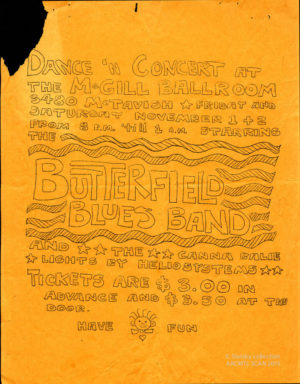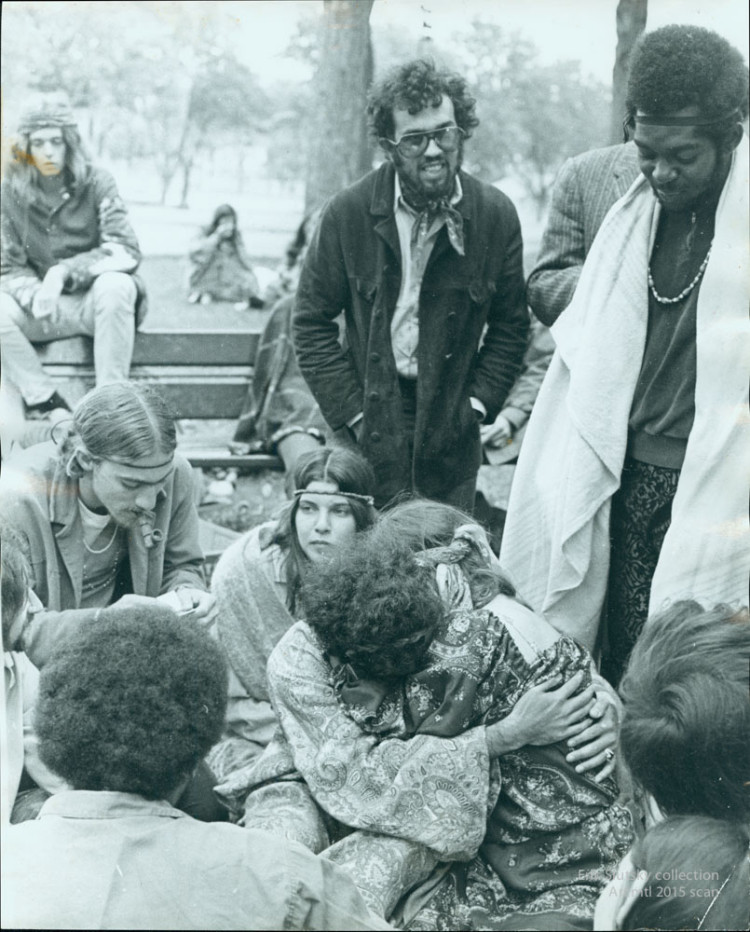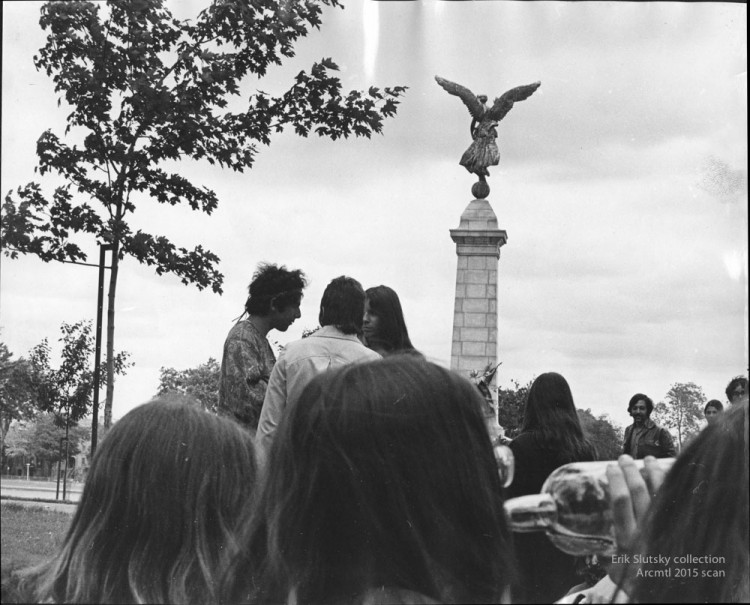Artist Erik Slutsky on Montreal’s 60s – 70s music scene
LR: No one ever copied the tapes or made any use of them?
ES: No I don’t think so. That was going to be the next level. And that was going to require time we weren’t willing to give. We were just trying to get a manager at that time. We got Sheldon Kagan. Donald K. Donald was already doing okay, so I guess he was working only with people that were being recommended to him. Kagen was still looking, so we had him come over and listen to us. We broke up like just a few months after that. And I think he did get us a few shows.
LR: Did you ever play any of these kinds of shows (holding up poster), at the Bonaventure Curling Club? Because they had 10 bands on the bill those days.
ES: We may have, but I am not sure.
LR: Were you too young in the heyday of these big all-day shows, way out at Côte-de-Liesse, or the Maurice Richard arena…
ES: I think Maurice Richard for some things. Bonaventure was in a kind of difficult to get area if you didn’t have a car.
LR: On this poster they showed the bus to take, the 16, which ironically is still the bus that goes through Graham in TMR. The Saint-Laurent auditorium, which is where I believe the CEGEP is, seems to have been a pretty busy venue.
ES: I remember going to a rock show at Vanier College at the back of the College. We either had an all-day or a weekend kind of rock festival, I must have been about 17 at the time and I had stopped using acid. Up until that point, dropping acid was a really big thing for about two years, roughly 1967 to 1969. By the time I went to this Vanier College thing, it was probably local bands like the Rabble playing. Vanier had a Red Cross tent set up, because a lot of people ended up with bad trips. I even volunteered to work for the Red Cross to help young people who were going through bad trips because I knew all about that shit. Some of my best friends experienced pretty traumatic hallucinatory effects from it, and after that I decided that I wasn’t going to take it anymore. I figured that I’d seen good trips, bad trips, if these kids are having bad trips maybe I can help a little bit. You just have to sit with someone and reassure them.
LR: I think that was the main thing is that you felt that you were permanently in this state.
ES: Yeah, there was that fear, because you lose all sense of time. Your mind just kind of floats away. We had learned from the most experienced acid users that the best thing was, don’t think about time. You had to empty your calendar and your schedule with any possibility of maybe having to go home for dinner, meet your parents or your grand mother or go to school. You had to have this big long space, maybe 24 hours, where you could kind of disappear and just let it happen. You could just lie on the ground, listen to music or whatever and just let this hallucinatory effect do its thing. If you fought it, that’s when you had trouble.
LR: I presume your parents had no idea about this at the time.
ES: No.
LR: Did you have any friends with hippie parents or hip parents, beatnik parents?
ES: No. When they first found out that we smoked marijuana, when I was about 15, 16 — it was just marijuana they discovered, but we were taking mescaline, we were taking speed, we were taking mushrooms, whatever we could get—but when they found out, their reaction was to blame a friend of mine, saying he was a bad influence and that I couldn’t see him anymore and that I should go see a psychiatrist. It wasn’t unusual then to hear how marijuana was the gateway to heroin. Basically, once the kids started to smoke marijuana, you were just on the road straight to the end. It seems ridiculous but I guess our parents were frightened for us. It just came across as a conflict of these two generations.
Of course, I never went to a psychiatrist. I said to my dad: Okay, I will go to the psychiatrist if you quit cigarettes. He couldn’t quit smoking cigarettes and I never went to the psychiatrist. And then somehow it just, I don’t know, they kind of liberalized a little bit.
I smoked pot for the first time I remember at 13 and then I probably smoked it everyday for the next five years. I was pretty much stoned throughout high school.
LR: Was it just around, or did you have to go and find a dealer …
ES: We had a dealer, he was the brother of a friend of ours. He was just a neighbourhood guy, 5 years older than us. We’d get hash and grass from him, we would usually buy it as a group, like we would each put in five bucks or something. We would go to the park at night and smoke, or usually we would smoke pot at recess in high school, that’s why I was stoned throughout high school. Yet it didn’t make a difference. I did very well in school– except that I would fall asleep sometimes in typing class, which was just after recess or lunch when we’d smoke. My head would collapse onto the typewriter, because nobody cared about the typewriting teacher. She didn’t seem like an important individual in the school. It’s not a nice thing to say, but that’s how the poor typewriting teachers were treated.
LR: I think it’s par for the course in 67, 68, I mean we are talking about the music scene, right?
ES: Yeah, and they seem to go along very much with each other. A typical break in the New Penelope was to go next door into the Swiss Hut, which was a bar/ tavern and we would smoke weed in the bathroom. At the urinals, each guy would pass a joint to the next guy, and often the guy next to you would be the guitar player for James Cotton or the bass player for Paul Butterfield that came for a beer during the break. You would go in for a beer, even if we weren’t old enough, it didn’t make any difference, you’d go in and drink one of the big beers and maybe have chicken livers in a basket, I think it was. The Penelope only had coffee. But the Swiss Hut was a dump.
LR: Was it like what we would call today an old man bar…
ES: Probably during the day, but in the evenings when there were shows at the Penelope, it was filled with people from the Penelope. So probably from 8 until midnight, they got a good crowd from the New Penelope. If there were old people in there, like I know now, 50 years later, they weren’t visible to us. As you get older, you get more invisible to younger people. They can look right through you, and I guess we didn’t even see them.
LR: Do you remember leaving at 2 in the morning or something from the New Penelope, what it was like: Sherbrooke and Pine Avenue, lot of hustle and bustle, or was it quieter than compared to today?
ES: I don’t think it was at 2 o’clock in the morning when shows ended though, because when I came home my dad would usually be up waiting for me. We would talk about the shows afterwards with milk and cookies. Probably was around midnight.
I have no idea why the New Penelope never had a liquor license. It sure would have helped him, (owner Gary Eisenkraft) considering that coffee was 30 cents a cup. And that was the only thing he sold.
LR: Did he at least have snacks– I mean, how else would you make money aside from the 3$ at the door?
ES: Yeah, it was like $3 to see Paul Butterfield. The club only held maybe when it was full, 150 people or something? At most. So that would be like $450, maybe make a total of $500 or $600 in a night. What was he paying Paul Butterfield, $300 for a week for all of his musicians? I heard he was in debt when he closed. He was probably working for free and putting in his own money hoping I suppose at some point, something would happen. I wonder, did he want a liquor license? Did you have to pay the cops to get a liquor license?
LR: Sounds like a lot of the money was going off next door.
 ES: Yes, because between sets could be a good 45 minutes. Sometimes bands would come back pretty drunk or stoned. I didn’t know anything about Gary Eisenkraft by the way until the Facebook group, when I found out a lot about him from guys a few years older than me. I can’t believe that a guy as young as he was was able to pull off all this stuff. To get all these people there (pointing at the posters.) The musicians that went through there had a huge influence on the city’s musicians, both French and English. I found out that a lot of French people went to a lot of those shows. (Looking at a ticket for a John Mayall, Sonny Terry – Brownie McGee show)
ES: Yes, because between sets could be a good 45 minutes. Sometimes bands would come back pretty drunk or stoned. I didn’t know anything about Gary Eisenkraft by the way until the Facebook group, when I found out a lot about him from guys a few years older than me. I can’t believe that a guy as young as he was was able to pull off all this stuff. To get all these people there (pointing at the posters.) The musicians that went through there had a huge influence on the city’s musicians, both French and English. I found out that a lot of French people went to a lot of those shows. (Looking at a ticket for a John Mayall, Sonny Terry – Brownie McGee show)
The Student Union was a pretty wild place. The McGill Ballroom too—I found out later that one of the McGarrigle sisters or both were involved in the light shows at the McGill Ballroom. They used to have these slideshows and light shows, which went along with the LSD situation at the time because everybody was tripping.
LR: As far as weed smoking, did it never happen at the Penelope?
ES: No, never. I never remember anyone smoking.
LR: But it was a smoking venue, you couldn’t have a no smoking sign for cigarettes I presume?
ES: I guess there was. I wasn’t a smoker at the time and it’s funny how there’s certain times when people can actually ignore people smoking. It sounds crazy today. In the sixties, everybody was smoking. It must have been pretty smoking in the New Penelope I imagine, I do remember going to clubs where you basically walk in to a cloud of smoke but we just didn’t realize it. I used to go to the Esquire, on Peel near Ste-Catherine. it was a pretty cool place.



